Search: Tackle Bag Hit Then Into 3 V 2
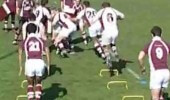 0:21
0:21
6 v 2 v 2 v 2 v 3
Developing the skills into decision making down a channel
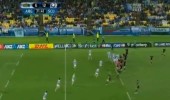 0:19
0:19
Men's - 3 v 2 1
A passage of play that shows how to attack with more attackers than defenders, a 3 v 2. The winger shows that strong running and determination can break tackles. Click on the practises in this section for coaching ideas
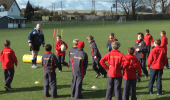 2:15
2:15
Passing - 3 v 2 Live Defenders
Gradually progress from 2 static defenders, to 3 v 2 roaming defenders. The first two players must draw their defenders before giving the pass.
To watch over 2500+ videos join now for free!
JOIN NOW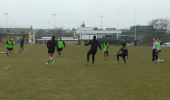 2:59
2:59
Quins Defence - Tackling in units 3 v 3
This exercise is part of a tackle technique progression and pitches 3 attackers v 3 defenders. As in match play the attacking players will present different challenges to the defenders. The coaches can choose to alter the conditions to put more or less pressure on the players
 0:15
0:15
Women's - 2 v 3 1
Women's - 2 v 3 1
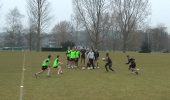 2:59
2:59
Quins Defence - 2 v 2 tackling
A progression from the 1 v 1 drill this exercise adds extra players to make the decision making process more realistic. The coaches can vary the delivery of the ball and the width of the area to put different conditions to the players
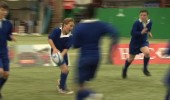 0:26
0:26
3 v 2 in Channel
A development of the 2 v 1 and 3 v1 drills, the attackers now must beat 2 defenders. This requires more decision-making ability as the movements of the defenders could change every time. Players must communicate as well as continue to perform their handling and running skills.
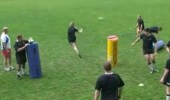 0:26
0:26
Tackle bag drill 3 man support after tackle
This is a very effective drill for developing decision making and awareness in support runners off a tackle situation
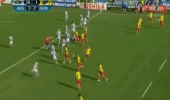 0:20
0:20
Men's - 3 v 2 2

Junior - 3 v 2 2

Women's - 2 v 3 2
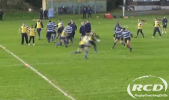 0:46
0:46
3 v 2 and then another defender
Develop decision-making skills in attack. 3 attackers must beat 2 defenders, before facing a third immediately after.
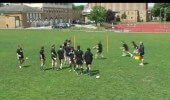 0:33
0:33
3 v 2 in channel
A good progression from the 2 v 1 drill
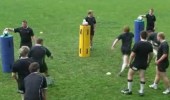 0:25
0:25
Tackle bag drill one hit & support
support has to read whch bag is being tackled and get to be in support by reading the situation
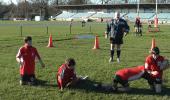 0:37
0:37
Tackling on Knees - 3 v 1
Using three attackers ensures the defender tackles on both sides and from slightly different angles. The coach can vary the pace and width of this exercise
11. 6 v 2 v 2 v 2
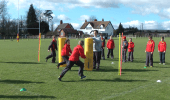 1:16
1:16
Passing - 3 v 2 Static Defenders
Progress to working in 3s against two static defenders. The pressure is on the middle player to hold their depth and perform a quick pass.
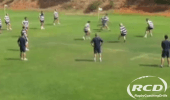 1:19
1:19
3 v 2 attacking practice
A useful drill to build decision-making skills. Attackers must choose from a variety of running and passing options.
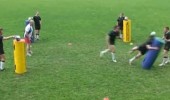 0:35
0:35
Tackle bag grid chase the tackler 2
a high intensity support and conditioning drill in a small space, that you can manage

Junior - 3 v 2 1
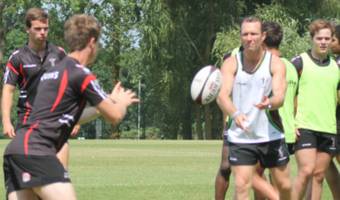 3:05
3:05
3 v 2 How to Fix Defenders
Running straight & fixing defenders is a skill that all players must learn and learn at an early age. The top players regularly practise this skill to maintain accuracy. This is the building block to scoring tries
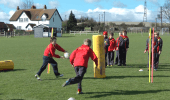 1:02
1:02
Passing - 2 v 1 Static Defender
Now working in just twos, we are concerned with depth, and the timing of the pass. Allow players to practice before adding a static defender. This can be a tackle bag as demonstrated. Players take the ball up to the defender but must complete the pass before they reach it.
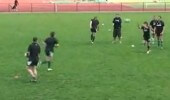
Passing 4 v 3 reset
A progression from 2 v 1 , 3 v 2 to 4 v 3
2-man Tackle and Decision-making
This practice develops communication in a three v three game format
Step 4 - Introducing the 2 v 2 Scrum
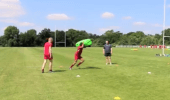 4:17
4:17
Technical Fitness with Tackle Bags
Tackle bags are a great tool to use in your conditioning sessions. The reduced impact allows players to peform high repititions of contact technique under fatigue, with low risk of injury.
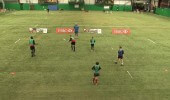 0:28
0:28
3 v 1 in Channel
A progression from the 2 v 1, where a second pass is encouraged to move the ball away from the defender.
Tackling 3 - Hunting a Tackle
Tackling - Hunting a tackle
Step 5 - Introducing the 3 v 3 Scrum
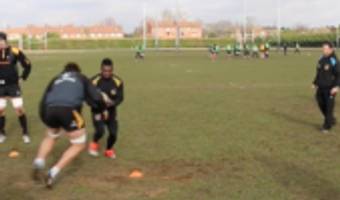 2:18
2:18
Tackling 20 - 2-man Tackle
Tackling 20 - 2 man Tackle
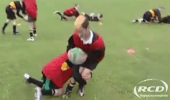 1:20
1:20
Introduction to tackling - Step 2
The transition from practicing tackling on knees to tackling on feet starts with the tackler remaining on their knees and the ball-carrier walking past. Then progress to having both players on their feet, but still executing the tackle at a controlled, walking pace.
 0:23
0:23
Junior - 2 v 1 2
Junior - 2 v 1 2
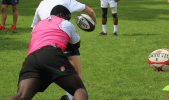 2:54
2:54
Quins - Tackle Technique 1 v 1
A new tackle technique exercise without the "Bone on Bone" collisions
Tackle technique 3
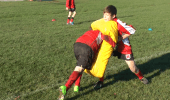 0:59
0:59
Tackle Technique - Down/Up and hit shield
Originally a rugby league practise this exercise is used for players to gain confidence in contact with both contact shields and the ground. Body position is important as is leg drive and the speed of hitting the ground and getting back up again. You can do this in lines and use it for fitness

Sevens - 2 v 1 2
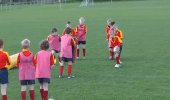 1:49
1:49
2 v 1 Passing
Adding a live defender helps to encourage players to hold their depth in support, so a good pass can be completed.
 0:25
0:25
Junior - 2 v 1 1
Junior - 2 v 1 1
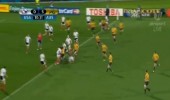 0:17
0:17
Men's - 2 v 1
A good example of phase play to create a 2 v 1 attacking platform. The initial deep pass then creates an overlap and the defender drifts to allow the attacker to run through easily.
Key factors : Quick ball at breakdown - Straight lines of running - Deep pass - straight lines of running again - Loud communication
 0:20
0:20
Junior - Wrap Tackle 2
Junior - Wrap Tackle 2

Women's - 2 v 1
Women's - 2 v 1
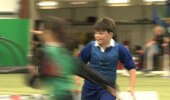 0:28
0:28
2 v 1 Draw and Pass
A basic 2 v 1 drill that encourages players to time their pass after they have drawn a defender, and for the supporting player to hold their depth.
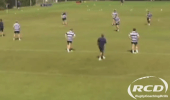 0:51
0:51
Attacking progression's 4 v 3
A progression from 3 v 2s, this drill is closer to a game situation, where there are more decisions for the attacking players to make. The gaps could appear in a variety of locations and they have several passing /running options. With 4 attacking players, you may wish to utilise your basic strike moves.
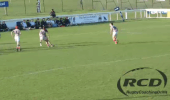
Sevens - 2 v 1
Having identified a 2 v 1 situation, the RGS Guildford player decides not to give an early pass from the breakdown, but instead to run and commit the defender before giving a pass to his teammate. Key factors: Timing - communication - accurate passing
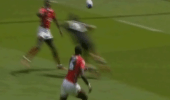
Sevens - 2 v 1
A variety of passes create a 2 v 1 which is executed perfectly for the outside attacker to score. Key factors : Different angles of running and support - Comunication - Ball presentation - Effective clearing of defenders at the breakdown - Accurate wide passes - Attack the inside shoulder of the last defender - Flat spin pass
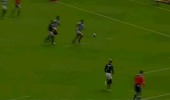
Sevens - 2 v 1
Seven's is about creating chances and then taking them. In this clip the Blue team take the ball up the middle of the pitch to draw in defenders, after recycling the ball they have a 2 v 1 opportunity, a straight line of running and a flat wide pass creates the try. Key factors : Call early - Run straight - Wide spin pass - Catch and swerve to score
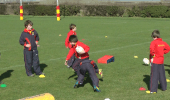 2:24
2:24
1 v 1 Tackling in Channel
An opportunity for players to put what they have learnt on tackle technique into practice. Each tackle is observed by all other players who can give feedback. Ensure all players have a go at attacking and defending.
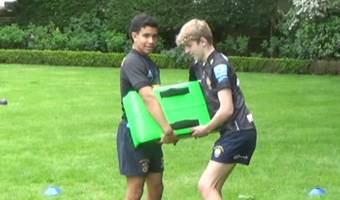 0:46
0:46
Tackle bag Grapple
In pairs. Each player grabs one end of the tackle pad. The players wrestle to grab the tackle pad from the other players grasp. Repeat a couple of times.
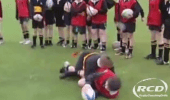 1:00
1:00
Introduction to tackling - Step 3
Repetitive exercises can help players become familiar with tackling technique.
Tackling 2 - Rugby Kibadi
 5:07
5:07
Tackle Technique - Full Session
[WITH DRILL VIDEOS] This session from Joe Goodman (Bristol University Rugby) has been designed to prepare players for a return to full contact competition, re-establishing correct technique to ensure safe, efficient tackling through progressively increasing the level of contact and complexity of skill execution.
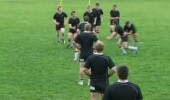 0:10
0:10
Offload out of the tackle in channel 2
A good progression for developing difficulty from a standard drill, look at carrying the ball and moving the defender so that you can ride the tackle
Step 3 - Introducing the 1 v 1 Scrum
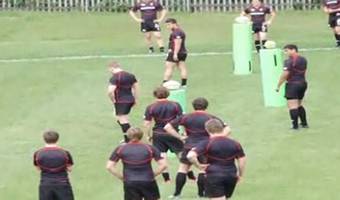 2:53
2:53
L2 - Conditioning Circuit
Using the full length of the pitch the practice is a continuous 3 v 2 scenario. • 3 attackers knock over a bag to collect a ball and attack 2 defenders in the 5m channel. • If they fail to beat the defenders (touch/grip), the attackers run back to knock over another bag and start again. • Having beaten the first defenders they carry on with the same ball to beat 2 further defenders who may choose a colour and start from the appropriate cone. • If the attackers fail to beat the defence they run back to the bag and start again with another ball. The defence can choose another colour to start from. • The next challenge is two free roaming defenders. If the attack fail they go back and knock over another bag to start again. • Finally the defenders choose a colour to start from and if the attack fail they get another ball and the defence choose another starting colour. • The objective is to complete the attack with the starting ball and restarts. Keep score to create competition

Men's - Classic tackle 3

Men's - High Tackle 2
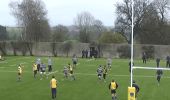 1:00
1:00
Attack Grid - 4 v 2
This continuous exercise puts pressure on your players to think fast and be ruthless in attacking the space. Coaches can change the size of the grid and the number of defenders to make it an easier game
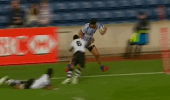
Sevens - Classic Tackle 2

Sevens - Classic Tackle 3
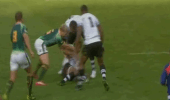
Sevens - Wrap Tackle 2

Junior - Classic Tackle 3

Junior - Classic Tackle 2
1. Support - 1,2,3 Follow Through
Isolated technical practice
Courtesy of the SRU
Level 2 - Back Row Example Clip 3
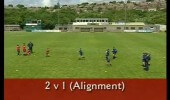 0:15
0:15
2 v 1 with withd & flat pass
These are core skill drills for youngsters to learn the game. As a coach you can alter the width and depth of the supporting players
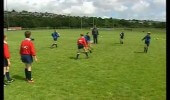 0:15
0:15
Introducing live defenders for 2 v 1
Developing passing skills with more pressure and intensity
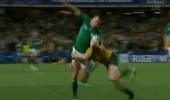
Men's - Classic tackle 2
Small -sided game - 5 v 3
This is an intuitive decision-making pratice
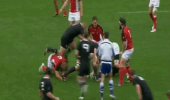
Men's - Wrap Tackle 2

Men's - Wrap Tackle 3
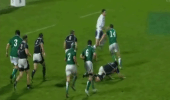
Men's - Incorrect Tackle 2
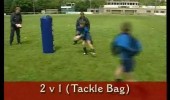
Learning to pass 2 v 1
Developing lines of running to attack the inside shoulder of defenders
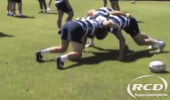 0:53
0:53
Scrum Technique 1 v 2
This drill acts as a warm up for the single player, with the other two simply providing resistance. The single player must maintain a strong body position and push the other two backwards.
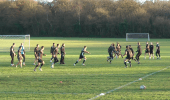 1:43
1:43
Broncos 4 - 6 v 3 Identify space
Players to attack with "Heads up" and identify where colleagues have space. Supporting players to call early to the ball carriers. Defenders to stay tight to not let attack through the middle spaces easily
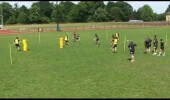 0:54
0:54
Change the point of attack - 4 v 3
This drill allows you to develop decision making by varying the attack and defence continually thus accelerating learning
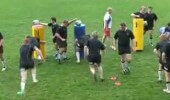 0:25
0:25
Tackle bag drill in 4s with support
A progression for developing support after contact
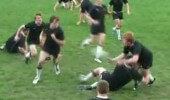 0:13
0:13
Offload out of the tackle with ball in 2 hands
Keeping the ball in two hands is a core skill and one that needs to be developed at ALL ages
 1:32
1:32
Quins Defence - 1 v 1 tackle skills
Close contact in a small channel ensures the players work their movement skills in both attack and defence. The coach reinforces the skills for contact prior to progressing this exercise
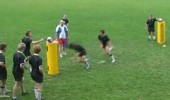 0:04
0:04
Tackle bag grid chase the tackler
A very effective support and conditioning exercise, you can change the space and pace and duration of the work effort
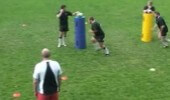
Tackle bag chase the tackler
This will act as a conditioning and as a support drill, working both players hard
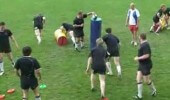 0:14
0:14
Tackle bag & support hi intensity drill
Sometimes a high intensity, high repitition drill is very effective at getting the point home
11. 4 v 2 Continuous Touch Rugby
Contextual Clip 3 - Tackle
Foul Play Clip 2 - Tackle
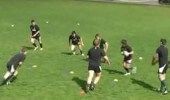
4 v 3 after 5m reset
Core skills training
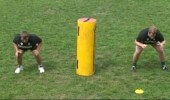 0:15
0:15
2-man lifting practice with pad
A good foundation exercise for technical development of practicing lifting with a tackle bag. You could use a contact pad or a tyre if you do not have a tackle bag. Key factors : Strong body position - Fast feet - Straigh back - Lock out the arms - Use momentum of both players
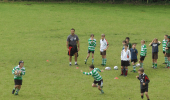 1:00
1:00
Attack 2 v 1
A good decision-making exercise which requires players to practice their basic running and passing skills
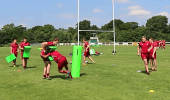 2:27
2:27
Reaction Tackle
Keep your players on their toes with this quick-fire 1v1 tackling exercise. Start with bags then progress to live tackles. Defending players have an obstacle to negotiate before performing the tackle, just as they may have in a game.
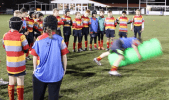 5:51
5:51
Tackling - When is the tackle completed?
It is very much an individual choice as to when a tackle is completed to when the defender can compete for the ball. What is generally accepted is that good tackle technique will enable the defender to "Be ready" for his next task. This clip explores why a strong grip or "Ring of steel" will enable the tackler to be dominant
 5:28
5:28
Kiwi Tackling - Pre Tackle Practises
Sharing our coaching ideas is great for the game. Players in New Zealand hone their skills at an early age and it is globally accepted that they have the best techniques across all positions. Coaching the tackle is a key fundamental that all players practise regularly
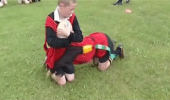 5:54
5:54
Defence - Tackle Progressions
Understanding tackle techniques and the progressions is integral for all coaches as a basic fundamental in coaching contact. The IRB "rugby ready" course provides a step by step approach to compliment the technques in this section
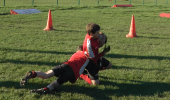 0:14
0:14
Tackle on Knees
This exercise asks players to attack from the front while still on their knees. It is important than the tackler pushers his shoulder through onto the outside hip of the attacker with the head staying outside as well. 1. Shoulder. 2 Arms tight 3. Drive
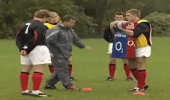 12:52
12:52
Tackle Technique - Progressions for Juniors
This clip illustrates tackle technique using progressions suitable to all players and possibly requiring regular revisit to embed safe and effective tackling
Step 2 - Introducing Competition for the Ball
Impact Guard Tackle
This tackle is used when close to either try line and intended to stop the ball carrier from moving forward
 4:29
4:29
Kiwi Tackling - Coaching Dominant Tackling
To be a dominant tackler you need to practise the core skills regularly. The tackle has many factors to it and here are some tips from New Zealand
Tackling 10 - Side-on Tackle
 6:05
6:05
Tackle Technique & Progressions
Introducing tackle technique to players is a challenging process and the Wasps coaches ensure the players understand and are competent at each step prior to progressing to the next one
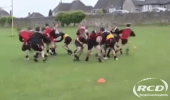 0:50
0:50
Introduction to tackling - Step 4
Jailbreak is a fun game that allows young players to become familiar with live tackling, as well as evasion. The game is played in a small area, to the increase the chance of tackles being made, and reduce the speed of the ball-carriers.
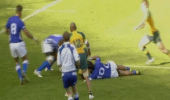 0:59
0:59
Sevens - Turnovers and move the ball 2
A turnover from a strong tackle and quick "Jackle" where the defender uses the momentum of the attacking player to swimg up onto his feet and contest the ball, this results in a line break. Key factors : Tackle technique - Urgency to get up to feet - Core strength - Speed

